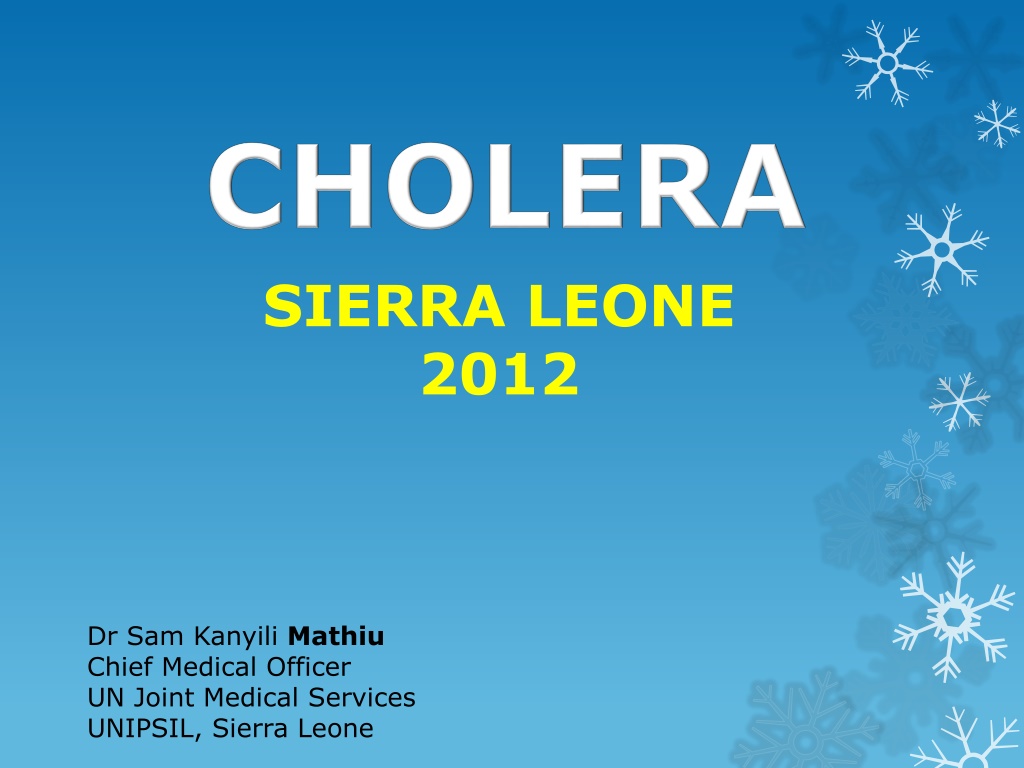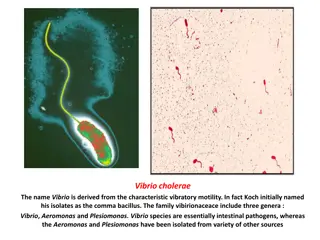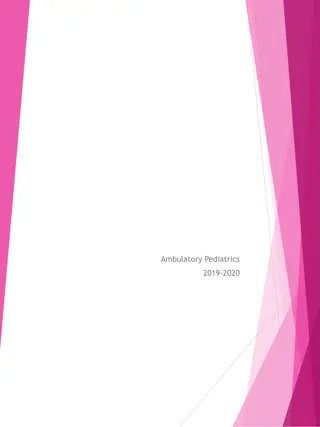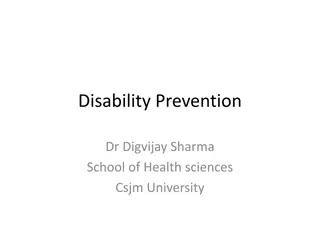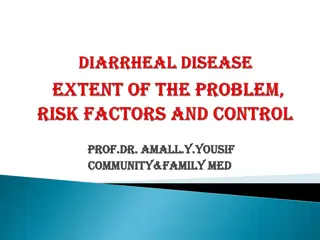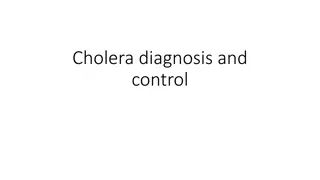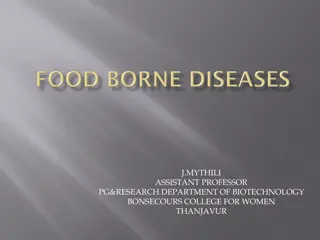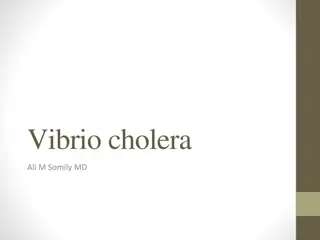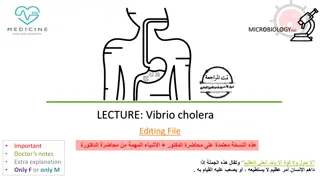Understanding Cholera - Causes, Symptoms, and Prevention Strategies
Cholera is an acute intestinal infection caused by the bacterium Vibrio cholerae. It leads to watery diarrhea due to the production of a potent enterotoxin. The disease has two distinct life cycles - one in the environment and one in humans. Factors such as access to safe water and sanitation play a crucial role in the spread of cholera. History reveals multiple pandemics worldwide, with Africa and Asia being heavily impacted. Prevention focuses on maintaining clean water sources and proper hygiene practices.
Download Presentation

Please find below an Image/Link to download the presentation.
The content on the website is provided AS IS for your information and personal use only. It may not be sold, licensed, or shared on other websites without obtaining consent from the author. Download presentation by click this link. If you encounter any issues during the download, it is possible that the publisher has removed the file from their server.
E N D
Presentation Transcript
SIERRA LEONE 2012 Dr Sam Kanyili Mathiu Chief Medical Officer UN Joint Medical Services UNIPSIL, Sierra Leone
What is Cholera? Acute intestinal infection caused by a bacterium called Vibrio cholerae which attaches to the intestinal wall and produces a potent enterotoxin (CTX) that interferes with normal flow of water and sodium chloride, hence causing copious, painless, ordourless watery diarrhoea Vibrio cholerae, has two distinct life cycles: - Environment : Cholera bacteria occur naturally in coastal waters where they attach to tiny crustaceans called copepods. Global warming, and mutations in the bacterium itself raise questions about the future of cholera and its eventual eradication Humans. Incubation period of less than 1-5 days.
Contd Most persons infected with V. cholerae do not become ill, although the bacterium is present in their feaces for 7-14 days. When illness does occur, about 80-90% of episodes are of mild or moderate severity and are difficult to distinguish clinically from other types of acute diarrhoea. Less than 20% of ill persons develop typical cholera with signs of moderate or severe dehydration. Factors to consider: access to safe drinking water and adequate sanitation. Risk of epidemics is highest when poverty, war or natural disasters force people to live in crowded conditions without adequate sanitation. The great irony is that unlike many infectious diseases, cholera is easily treated. Death results from severe dehydration, which can be prevented with a simple and inexpensive rehydration solution.
History First epidemics seem to have originated in India. In the early 19th century, the disease began to appear in other parts of the world in the trade and colonization routes Just 100 years later, six major epidemics had swept the globe. The seventh pandemic began in Indonesia in 1961 and has since affected more than 100 countries. In 1998 and 1999, more than 400,000 people in 14 African nations contracted the disease. Hardest hit was sub-Saharan Africa, where cholera remains endemic. In the same year, cholera appeared in South America for the first time in nearly a century spreading to Central America and Mexico. These epidemics were caused by a single strain of bacteria, V. cholerae O1 In 1993, a new strain, V. cholerae O139, appeared in Bangladesh and India.
Sources of Cholera Surface or well water. Cholera lies dormant in water for long periods of time and contaminated public wells are frequent sources of outbreaks. Inadequate sanitation and in areas hard hit by natural disasters or war. People living in crowded camps or slum areas are especially at risk. Water stored at home also can become contaminated. Bathing, brushing or washing dishes in water with cholera bacteria Seafood. Eating raw or undercooked seafood, especially shellfish that originates from certain locations can expose you to cholera bacteria. Raw fruits and vegetables. Raw, unpeeled fruits and vegetables are a frequent source of cholera In developing nations, manure, fertilizers or irrigation water containing raw sewage can contaminate produce in the field. Fruits and vegetables may also become tainted during harvesting or processing. Grains. Rice, sorghum and millet that are contaminated after cooking and allowed to remain at room temperature for several hours are a perfect medium for the growth of V. cholera.
Who is at risk getting Cholera? Everyone is susceptible to cholera, with the exception of nursing infants who derive immunity from their mothers' milk. Still, certain factors can make you more vulnerable to the disease or more likely to experience severe signs and symptoms. These risk factors include: Malnutrition. Malnutrition and cholera are interconnected. People who are malnourished. Reduced or nonexistent stomach acid (hydrochlorhydria or achlorhydria). Cholera bacteria can't survive in an acidic environment, and ordinary stomach acid often serves as a first- line defense against infection. People with low levels of stomach acid lack this protection. Children and older adults tend to have lower than normal stomach acid levels. Gastric surgery and treatment for ulcer lower the acid levels.
Household exposure. You're more likely to develop cholera if you live with someone who has the disease. Up to half of household contacts of infected people also become sick. Compromised immunity. If your immune system is compromised for any reason, you're more susceptible to cholera infection. Type O blood. For reasons that aren't entirely clear, people with type O blood are twice as likely to develop cholera as are people with other blood types. Raw or undercooked shellfish. Eating raw shellfish particularly oysters from waters known to harbor the bacteria or shellfish transported by travelers from countries
What are the signs and symptoms of Cholera? Most people exposed to cholera don't become ill and never know they've been infected. Yet because they shed the bacteria in their stool for seven to 14 days, they still have the potential to infect others. The great majority of people who become sick experience mild or moderate diarrhea that's often hard to distinguish from diarrhea caused by other problems. Only about one in 10 infected people develop the typical signs and symptoms of cholera, which include: Severe, watery diarrhea - Diarrhea comes on suddenly. It's often voluminous, flecked with mucus and dead cells, and has a pale, milky appearance that resembles water in which rice has been rinsed (rice water stool). What makes cholera so deadly is the loss of large amounts of fluids in a short time as much as a litre an hour.
How is Cholera diagnosed? Clinical Signs and Symptoms Laboratory tests Although the signs and symptoms of severe cholera may be unmistakable in endemic areas, the only way to confirm a diagnosis is to identify the bacteria in a stool sample. But because cholera needs immediate treatment and because all cases of watery diarrhea are treated in the same way, doctors are likely to begin rehydration without a definitive diagnosis. They're also likely to carefully monitor vital signs such as blood pressure and pulse as well as blood sugar levels, electrolytes, and the amount of oxygen and carbon dioxide in the blood all of which can be affected by the severely dehydrating effects of cholera
Prevention at a personal level Always wash your hands with soap after using the toilet, after cleaning a baby s bottom, before handling or eating food, and before feeding a child. Avoid eating raw food or food from sources whose cleanness you cannot verify Use only boiled water from a safe water sources piped or from protected well, to drink and to wash your food
Wash all fruits and vegetables well with safe boiled water, and/or peel them with clean hands before eating. Keep boiled drinking water in a clean covered container and always keep your food covered to protect it from flies Always use a clean cup to collect drinking water from the container and do not touch the water with your hands Always use a toilet/latrine when you have to use the toilet Keep the toilets/latrines clean at all times and always cover them to avoid flies Stay away from Fish / Seafood particularly taken from contaminated water and eaten raw or insufficiently cooked. Stay away from fruits and vegetables grown at or near ground level, irrigated with water containing human waste, or "freshened" with contaminated water, and eaten raw
Community-wide prevention Any community affected by cholera is in urgent need of clean, safe food and drinking water and an effective and sanitary method of waste disposal. Mobile water purification plants, for instance simple systems in which contaminated water is chlorinated, filtered and then trucked may have helped prevent diarrheal disease following the December 2004 Indian Ocean earthquake and tsunami. Also key is providing sanitary facilities that respect local beliefs about privacy and cleanliness. Mass vaccinations and routine treatment of a population with antibiotics won't stop the spread of the disease. Travel restrictions between countries or between affected areas will also not curb the spread.
Other public health interventions that may be considered in serious outbreaks Closing of markets and other public places Closing schools and other education institutions Closure of uninspected restaurants and other eating places Banning social gatherings weddings, parties etc Socio-behavioral adjustments handshaking, communal eating
What is the treatment for Cholera? At home Oral Rehydration Salts (ORS). One packet ORS should be mixed with 1 liter of boiled water Sugar Salt Solutions (8 table spoons of sugar and 1 table spoon of salt mixed with 1 liter of boiled water) Babies who have Cholera should continue breastfeeding, if possible more often than usual. People who have Cholera should be encouraged to drink fluids after vomiting.
In a health facility The World Health Organization (WHO) Protocol WHO-ORS powder that can be reconstituted in boiled or bottled water The goal is to replace fluids and electrolytes lost through diarrhea using a simple rehydration solution that contains specific proportions of water, salts and sugar. Severely dehydrated people need intravenous fluids, which are more expensive and difficult to administer. Without rehydration, approximately half of people with cholera die; with treatment, the number of fatalities drops to less than one percent. People who have trouble drinking ORS, either because of frequent vomiting or the sheer volume of fluids may need infusion through their veins (intravenous treatment) In addition to rehydration, people who are very sick may benefit from antibiotics, which can cut the length of the illness in half.
Update on the cholera vaccine The traditional injected vaccine offers minimal protection. No cholera vaccine is currently available in the UN clinic. A few countries offer two new oral vaccines that may provide longer and better immunity than the older version did No country requires immunization against cholera as a condition for entry
Press and comments The fatality rate is very high, Minister of Health, Zainab Bangura, It is pretty serious. At the moment our strategy is to contain it [the disease] and to clean the environment. Dr Alemu Wondimagegnehu, Country Director WHO said. It is the biggest outbreak since 2007. For a population of six million, 4,000 cases are significant - this is big. The situation in Marbella, with lack of sanitation and hygiene, lack of safe drinking water and the [poor] management of food in the market area - all these are risk factors for [the outbreak] to escalate, .
Contd Jens A. Toyberg-Frandzen, The Executive Representative of the Secretary General in SL . Cholera can kill you and is transmitted easily which makes it a very dangerous disease. However, it can be cured if detected and treated in time. Furthermore, it can be prevented through thorough hygiene practices. Therefore, I urge you all to carefully update yourselves on the symptoms of the disease, on how it is transmitted as well as how you can protect yourselves and your families A Cholera patient told me I felt so ashamed and helpless the watery leakage was so much. I felt like my backside plumbing system had completely broken down!
Cholera in Sierra Leone 2012 On 27 February 2012 the MOHS declared outbreaks of Cholera in Kambia, Port Loko and Pujehun districts On 16 July 2012 the outbreak was declared in Western Area including the capital city of Freetown and since then there has been a rapid and sustained spread with 80-100 new cases reported daily. Late July 2012 the outbreak spread to far districts of Bombali, Bo and lately Moyamba, ?Tonkolili. Therefore it may be assumed that the outbreak is taking a national outlook. Since January and by 3 August 2012 6374 cases, 119 deaths reported, with 2406 being children under five Rapid rise in Western Area in the last week 1383 cases.
Sierra Leone Stakeholders Interventions The MoHS, UNICEF, WHO, MSF, GOAL and other partners response to outbreak Free Cholera Treatment Units have so far been set up in Mabella, Macauley Street, Connaught Hospital, Lumley and Wellington. Strengthening of surveillance systems, chlorination of water sources and water quality testing Training of health workers on case management, Provision of supplies and community sensitization as well as hygiene promotion activities.
